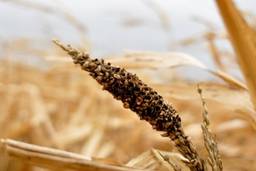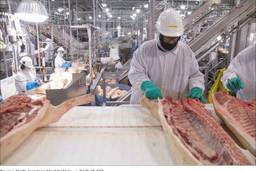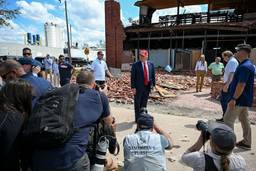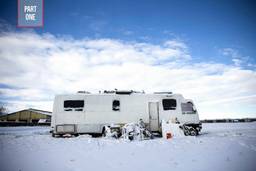Food Production is a Major Cause of Climate Change, but Farmers Can be Part of the Solution
Christopher Walljasper

Editor’s Note: This story was originally published on The Midwest Center for Investigative Reporting.
Farming, more than any other industry, might be the best hope for curbing climate change.
The global food production system, which includes agriculture, accounts for more than a third of man-made greenhouse gases, according to an August report from the United Nations’ Intergovernmental Panel on Climate Change.
And while past focus has been on industries such as fossil fuels and transportation, new attention is being put on agriculture’s role in the climate change solution. On Sept. 18, a coalition representing 10,000 farmers and ranchers delivered a letter to Congress supporting the Green New Deal, a congressional resolution to transition the United States to 100 percent clean energy by 2030.
“Farmers and ranchers are on the front lines of the climate crisis. Their livelihoods are put at risk by more intense droughts and storms and flooding, and extreme heat and humidity are endangering the health of farm workers,” said New Mexico Congresswoman Deb Haaland at a press conference announcing the coalition. “It makes all the sense in the world that farmers and ranchers support our Green New Deal resolution.”
Haaland cosponsored the Green New Deal when it was introduced in February 2019.
The UN’s August report warns that man-made emissions have already begun to threaten the world’s food security.
As the warnings of climate change begin to be measured in years and decades rather than half-centuries, changing the way the world grows, distributes and consumes food could help slow the effects, the report suggests. But some scientists say a slow rollout of conservation practices that minimize soil erosion, deforestation and greenhouse gas emissions may be too little, too late.
“Ignoring climate change will hurt agriculture in the long run,” said Benjamin Houlton, director of the John Muir Institute of the Environment at the University of California, Davis.
The rapid deforestation of the Amazon rainforest highlights the way the world’s consumption can conflict with the desire for conservation.
While the world’s most powerful nations pledged $40 million to help stop fires from raging in Brazil’s Amazon rainforest, they failed to recognize that many of these fires were set to clear land for cattle pastures and soybean production, according to the Amazon Watch, a nongovernmental organization focused on protecting the rainforest. Brazil’s president, Jair Bolsonaro, campaigned on a promise to bring economic development to the Amazon.
Even after Brazil’s president instituted a 60-day moratorium on burning in the rainforest, nearly 4,000 new fires have been observed by Brazil’s National Space Research Institute.
The trade war between U.S. and China may have contributed to these new fires.
China went from buying nearly 29 million metric tons of American soybeans in 2017 to less than six million, an 80 percent drop.
The country still needed much of that soy to feed its livestock, so it turned to Brazil, which increased its soybean exports to China, from just more than 50 million metric tons in 2017 to 66 million last year.
As the trade war between the U.S. and China continues to stall, Brazilian farmers see an opportunity to capture the Chinese soybean market long term, said Jim Sutter, CEO of U.S. Soybean Export Council.
“Growers in Brazil are getting a financial signal to grow more, because there’s a market for it. I think they’re ramping up to grow more,” he said.
Sutter said Brazil, with support from Chinese state-run companies like COFCO, is building infrastructure like ports and roads, to more efficiently transport crops from South American to China.
Shifting the Focus to Agriculture
Much of the climate change conversation over the last 30 years has been focused on the transportation and energy sectors, said Jason Clay, senior vice president of markets for the World Wildlife Fund. But that’s not because they are the biggest sources of emissions.
“The most greenhouse gasses have always been in the food sector. It’s just too big and complicated to actually figure out how to address it, through so many different producers and so many different supply chains,” Clay said.
Adjusting course in the way food is produced could scale back the impacts of climate change, and there are signs that some U.S. farmers and ranchers are already making strides to become more sustainable.
Clay says the federal government isn’t taking the steps needed to curb the effects of climate change on U.S. agriculture — news reports document the Trump administration’s efforts to deny climate science.and even repress studies that don’t align with its pro-business, anti-environment agenda.
“We don’t know the extent of the problem in the U.S. yet, because we haven’t documented it well,” he said. “They can’t even mention the words ‘climate change.’ It’s not going to be likely that they’re ever going to collect the data.”
Instead, the task of re-envisioning an agricultural model that is more sustainable is falling on the shoulders of individual farmers and agricultural businesses.
Modern Ag Has Solved Some Problems, Created Others
The UN report recognized the value of modern agriculture in feeding a growing population. It noted that meat supply per capita has doubled since 1961, with cereal crop production up 240 percent.
But it also pointed out that a third of all food is wasted, according to the UN’s Food and Agriculture Organization.
Increased food production has had an environmental toll.
Agriculture accounts for as much as 70% of fresh-water usage globally and leads to greater soil erosion and deforestation. Open soil heats up faster and lacks carbon capturing plants.
Clay said that, as more land is converted to farmland, more marginal soils produce less food per acre.
“That sprawl is actually a much bigger threat to biodiversity and ecosystems and climate change,” he said.
Kevin Fulton, a cattle rancher and crop farmer who runs around 800 acres near Litchfield, Nebraska, said he’s found greater efficiency by scaling back the size of his operation and introducing sustainable practices like organic farming and grass-fed beef.
“The animals are the most important part of the equation,” Fulton said. “They have to be on the landscape, not in some concentrated animal feeding operation in a corner, having all the feed hauled to them and having all the manure hauled back out. There’s just tremendous inefficiencies in those kind of systems.”
Changing Climate May Look Different Depending on Where You Live
The UN report explained how climate change will impact various parts of the world, and not all are apparently negative. Areas near the equator may see an expansion of desert-like conditions, challenging food production. Further north may initially see an increase in growing seasons and yields — a trend the U.S. Environmental Protection Agency has also observed.
Those extra days in the field will include more extreme weather, like the 2019 growing season.
“Climate change has already affected food security,” said the report. It warned of wildfires, pest outbreaks, “increases in rainfall intensity, flooding, drought frequency and severity, heat stress, dry spells, wind, sea-level rise and wave action, permafrost thaw.”
Kara Brewer Boyd, who farms 1,300 acres around Baskerville, Virginia, saw the volatility of climate change first-hand this spring. While flooding kept much of the Midwest from planting, drought kept her out of the fields.
“The ground was just so hard, you couldn’t break ground to get things in it,” she said. In the fall, it’s intensified moisture from tropical storms — a phenomenon she said didn’t affect her area decades ago. “There’s been times when we’ve actually lost crop because it’s been too wet in the field, and we couldn’t get it out. It rotted.”
According the the USDA Farm Service Agency’s August 12 report, farmers were unable to plant 19.4 million acres this year. That’s nine times the 1.8 million acres farmers left unplanted in 2018. For parts of the upper Midwest and east coast, above average moisture this fall could continue to hamper growers as they prepare for harvest.
Ripple Effects
For parts of the world, the effects of climate change aren’t 10 to 15 years away. They’re happening now.
The UN report said extreme weather will destabilize the food chain, “leading to higher food prices and increased risk of food insecurity and hunger. The most vulnerable people will be more severely affected.”
The cost of food will likely go up for everyone. As the ability to grow certain crops changes around the world, the need for international trade will also increase, as people rely on food grown outside of their region.
“Without trade, it’s going to be very hard to address food security issues at a global level,” said Clay. “There’s always going to be some places that are producing surpluses, and many places that are producing at a deficit.”
He said combative trade policies like that between the U.S. and China will exacerbate food insecurity at home and abroad. The report warns that, as the food system becomes less dependable, the changing climate could also increase migration of affected populations.
“Changes in climate can amplify environmentally induced migration both within countries and across borders,” the report said. “Extreme weather and climate or slow-onset events may lead to increased displacement, disrupted food chains, threatened livelihoods, and contribute to exacerbated stresses for conflict.”
That strain will ripple across rural America and low income communities, impacting nearly everyone. A 2018 climate assessment by the U.S. Global Change Research Program explained that, in addition to agricultural challenges, higher temperatures will disproportionately impact smaller communities, where access to healthcare can be more challenging as rural hospitals struggle to remain solvent.
Aging or insufficient water systems or telecommunications infrastructure are more susceptible to failure because of extreme weather caused by climate change.
Ag Solutions
There are farmers and agriculture businesses making efforts to lower their carbon footprints.
Bayer Crop Science is promoting cover crop adoption and Cargill recently announced it would reduce greenhouse gas emissions by 30 percent in the next decade. The plan includes emissions-reducing measures at several stages of the food production process, including feed grain production and reducing food waste.
But Fulton said he worries it’s not enough. By permanently moving his cattle from feedlots to pastures, he said he’s able to drastically reduce the carbon emissions his farm puts out.
“Regenerative agriculture really is the solution to this,” he said. “We see that carbon sequestration far exceeds carbon emissions on farms like mine.”
The benefits of small-scale versus large agricultural operations have been debated at great length, and depend largely on how they are measured. But Fulton said if reducing climate change is the measure, more diverse farming practices are the best way to reduce greenhouse gasses.
“I understand that there’s advantages to economies of scale and all that. But we need to look at how we measure efficiencies,” he said.
There is some political will to spur climate change reduction efforts in agriculture.
In August, presidential candidate and New Jersey Senator Cory Booker announced legislation that will incentivize carbon capture on farms, through practices like planting cover crops, no-till farming and planting waterways and conservation plots. The bill would also fund reforestation and restoration of wetlands.
Farmer support for the Green New Deal is relatively new. When the resolution came out in early 2019, several state Farm Bureau organizations criticized the movement as “vague,” “unrealistic” and overly critical of animal agriculture.
The new coalition backing the climate change resolution is also advocating for more agricultural representation in the Green New Deal.
“We believe these climate goals are achievable,” said the coalition’s letter to Congress. “But only if the GND (Green New Deal) includes policies that spur two large-scale transitions: the transition away from fossil fuels toward renewable energy alternatives, and the transition away from industrial agriculture toward family farm-based organic and regenerative farming and land-use practices that improve soil health and draw down and sequester carbon.”
Brian Duncan, a corn, soybean and hog farmer in Northeast Illinois, said he’s always focused on conservation, but worries studies on climate change such as the one from the United Nations could lead to onerous regulations that stifle business without fixing the problem.
“I, like other farmers, in response to weather patterns, continue to adopt conservation practices because it’s the right thing to do,” said Duncan.
There’s some skepticism about climate change among farmers, according to a 2012 study by Michigan State University. But many are realizing that there are things they can do to be part of the climate change solution.
Clay said there’s no easy solution to reducing emissions in the food system. Farmers can plant more trees and cover crops, but not at the rate forests and wetlands are being plowed under in developing countries. They can practice more sustainable crop rotation, no-till farming or restorative grazing for meat production. But individually, these practices won’t mitigate climate change.
“None of these are sufficient by themselves,” said Clay. “What are the different things you can do to add up to something more meaningful?”
The Midwest Center for Investigative Reporting is a nonprofit, online newsroom offering investigative and enterprise coverage of agribusiness, Big Ag and related issues through data analysis, visualizations, in-depth reports and interactive web tools. Visit us online at www.investigatemidwest.org






